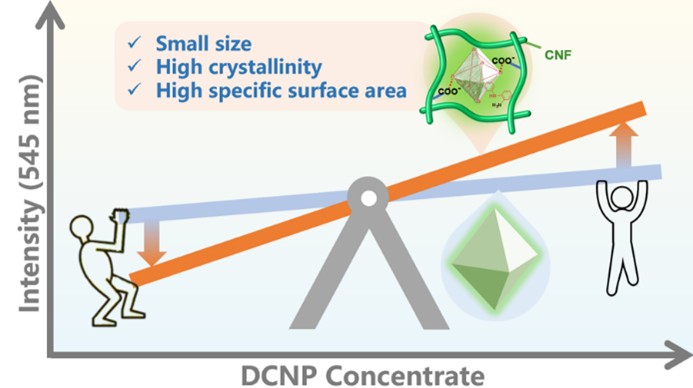Research Progress in Amino-Functionalized Nano UiO-66 for Detection of Nerve Agent Analog
Editor: | Apr 23,2025
Nerve agents, highly toxic organophosphorus compounds, inhibit acetylcholinesterase and can be lethal. Developing rapid detection technologies for sarin gas is crucial for national security. Metal-organic frameworks (MOFs), with their low density and high surface area, are ideal probes. However, the size modulation of metal-organic frameworks (MOFs) is of vital importance in sensing for enhanced performance, while the synthesis of nano-sized MOF nanocrystals with wide active reaction sites remains challenging. Here, Prof. DOU Xincun's lab at Xinjiang Technical Institute of Physics and Chemistry (XTIPC) of Chinese Academy of Sciences proposed a sustainable strategy through using carboxylated cellulose nanofibrils (CNFs) to induce in-situ growth of smaller, self-assembled UiO-66 with abundant active sites, enabling sensitive and selective recognition of nerve agent analogs. Not only a significantly low limit of detection (LOD, 4.2 nM/0.685 ppb) and robust selectivity against a wide range of common substances (>21 types) were achieved, but also immediate response to DCNP vapor (<1 s) was demonstrated by a sensing chip. The research, titled “Amino-Functionalized Nano UiO-66 for Detection of Nerve Agent Analog” was published in ACS Applied Nano Materials.
Benefited from the remarkably boosted active site quantity, the eliminated background fluorescence, as well as the superior charge transfer between the amino-group and analyte, an efficient fluorescent platform for the detection of nerve agent analog diethyl cyanophosphonate (DCNP) was established. Compared with the conventional hydrothermal synthesis of UiO-66 fluorescent probes, the small-sized UiO-66 probes synthesized in this study exhibit lower fluorescent background, faster response signals generation, and a LOD reduced by 8-fold. More importantly, the introduction of CNF endows them with excellent self-assembly properties, laying a foundation for the development of portable gas detection devices for target analytes.
The present strategy for uniformly dispersed MOF materials synthesis is expected to provide new perspectives not only for controllable functional nanostructure fabrication but also for achieving high-performance chemical sensors with practical application potential.
This work was supported by the National Natural Science Foundation of China, the China Postdoctoral Science Foundation, Tianshan Innovation Team Plan, the Youth Innovation Promotion Association, CAS, and the Scheme of Tianchi Talent on Doctor Introduction in Xinjiang.

Structure Design of UiO-66-based Fluorescent Probe and Its Schematic Diagram for Highly Sensitive Detection of DCNP (lmage by Prof. DOU Xincun 's group).
附件下载:
 (86) 991-3838931
(86) 991-3838931 lhskj@ms.xjb.ac.cn
lhskj@ms.xjb.ac.cn (86)991-3838957
(86)991-3838957 40-1 Beijing Road
Urumqi, XinjiangChina
40-1 Beijing Road
Urumqi, XinjiangChina